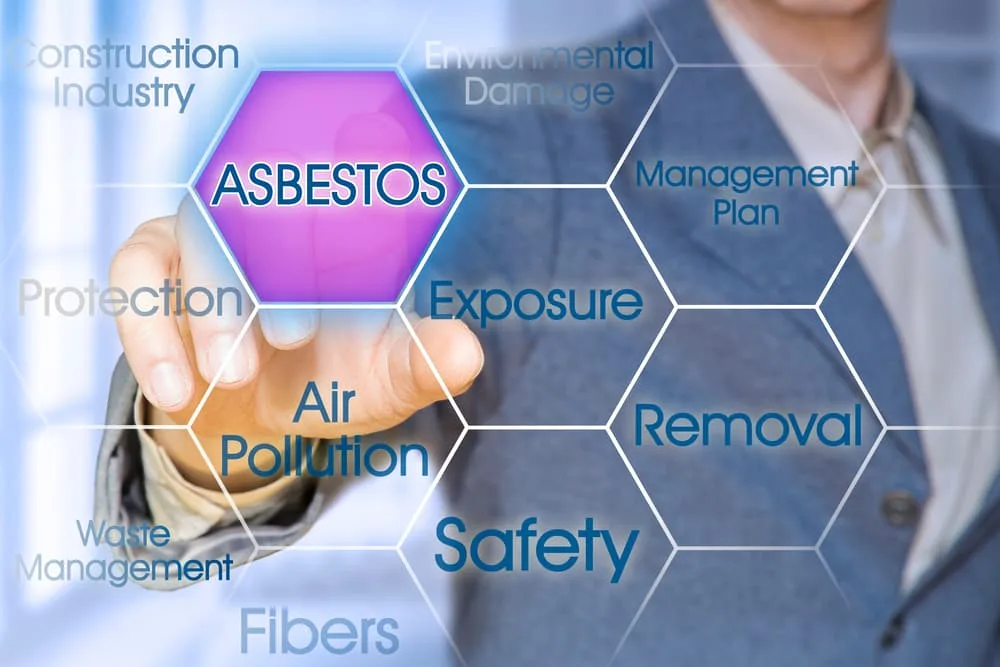There’s no such thing as mesothelioma lung cancer. However, asbestos exposure can cause mesothelioma as well as lung cancer.
Mesothelioma is a rare and aggressive form of cancer that develops in the lining of the lungs, abdomen, or other internal organs. Mesothelioma is almost always caused by exposure to asbestos, a fibrous mineral that was widely used in industrial products. Many factors can contribute to a lung cancer diagnosis, including smoking, air pollution, and asbestos exposure.
In this post, we’ll explore mesothelioma and asbestos-related lung cancer, and how skilled Chicago lung cancer lawyers can determine whether you qualify for compensation for your medical bills and other damages.
How Does Asbestos Exposure Occur?

Inhalation is the most common route of asbestos exposure. Tiny asbestos fibers can become airborne when asbestos-containing materials are disturbed, such as during construction, renovation, or demolition activities. People in the vicinity can then unknowingly breathe in these fibers. Once inhaled, the fibers can lodge in the lungs and other parts of the respiratory system, leading to various health issues over time.
Ingestion of asbestos can occur when small asbestos fibers become airborne and settle on surfaces, food, or water. People may inadvertently ingest these fibers by consuming contaminated food or water or touching their mouths with asbestos-contaminated hands.
How Can Someone Become Exposed to Asbestos?
Occupational exposure is one of the main forms of asbestos exposure. Many workers have historically been exposed to asbestos on the job, especially in industries that used asbestos-containing materials. These industries include construction, shipbuilding, automotive repair, manufacturing, and shipbuilding. Workers who handle or disturb asbestos-containing materials without proper protective measures risk inhaling or ingesting asbestos fibers.
Construction workers who renovate or demolish older buildings that contain asbestos-containing materials can inadvertently release asbestos fibers into the air. This includes activities like cutting, drilling, sanding, or breaking apart materials that contain asbestos, such as insulation, tiles, roofing, and siding.
In older homes, repairs, maintenance, or DIY projects can release asbestos fibers into the air, leading to exposure.
While the use of asbestos in consumer products has significantly declined, asbestos-contaminated products like talcum powder and certain cosmetic products can lead to exposure. However, regulatory agencies have taken steps to regulate and monitor the presence of asbestos in consumer goods.
Family members of workers who were exposed to asbestos on the job can risk secondary asbestos exposure. Workers who carry asbestos fibers on their clothing, skin, or hair can inadvertently bring those fibers home, exposing their family members to the risk of inhalation or ingestion.
What Is Mesothelioma?
Mesothelioma is not lung cancer. It’s a rare and aggressive cancer that primarily affects the lining of certain internal organs, most commonly the lungs (pleural mesothelioma) and less frequently the abdomen (peritoneal mesothelioma) or the heart (pericardial mesothelioma). The main cause of mesothelioma is exposure to asbestos fibers.
Mesothelioma is highly aggressive and difficult to treat. It has a long latency period, often taking 20 to 50 years or more to develop after asbestos exposure, which can make diagnosis challenging.
The symptoms of mesothelioma can vary depending on the location of the cancer. Common symptoms of pleural mesothelioma include chest pain, shortness of breath, persistent cough, and weight loss. Symptoms of peritoneal mesothelioma can include abdominal pain, swelling, and digestive issues. Diagnosis typically involves a combination of medical history, physical examination, imaging tests (such as X-rays, CT scans, or MRIs), and biopsy to confirm the presence of cancerous cells and determine the type of mesothelioma.
Treatment options for mesothelioma depend on factors such as the stage of the cancer, the patient’s overall health, and the type of mesothelioma. Treatment may include surgery, chemotherapy, radiation therapy, targeted therapies, and immunotherapy. Because mesothelioma is often diagnosed at an advanced stage, treatment options may be limited.
The prognosis for mesothelioma varies based on the stage of the cancer at diagnosis, the type of mesothelioma, and the overall health of the patient. Despite its aggressive nature and often late-stage diagnosis, advances in treatment options have provided some hope for improving survival and quality of life.
What Is Asbestos-Related Lung Cancer?

Lung cancer is a type of cancer that originates in the cells of the lungs. It is one of the most common cancers worldwide and a leading cause of lung cancer related deaths. Lung cancer typically begins in the cells lining the air passages of the lungs and can spread to other parts of the lung or nearby lymph nodes and other organs.
Asbestos-related lung cancer is a specific lung cancer directly linked to exposure to asbestos fibers. What distinguishes asbestos-related lung cancer is its association with asbestos exposure. The risk of developing this type of lung cancer increases with the amount and duration of asbestos exposure.
Similar to other asbestos-related diseases, a latency period between asbestos exposure and the development of lung cancer can range from several years to decades after exposure to when the cancer becomes clinically evident.
Smoking and asbestos exposure have a synergistic effect on the risk of developing lung cancer. Individuals who smoke and have been exposed to asbestos have a much higher risk of developing lung cancer than those exposed to asbestos alone or smoke alone. Some studies also suggest that asbestosis may lead to lung cancer or mesothelioma.
The symptoms of asbestos-related lung cancer can be similar to other types of lung cancer and may include persistent cough, chest pain, shortness of breath, weight loss, fatigue, and coughing up blood. Diagnosis involves a combination of medical history, physical examination, imaging tests (such as X-rays, CT scans, or PET scans), and biopsy to confirm the presence of cancerous cells.
Treatment options are similar to other types of lung cancer and may include surgery, chemotherapy, radiation therapy, targeted therapies, and immunotherapy. The treatment plan depends on the stage of the cancer, the overall health of the patient, and other individual factors.
Because asbestos-related lung cancer shares many characteristics with other forms of lung cancer, it’s crucial for individuals with a history of asbestos exposure to inform their healthcare providers about their exposure history. This information can guide proper evaluation, diagnosis, and treatment planning.
Is Asbestosis a Type of Cancer?
Asbestosis is a chronic lung disease caused by prolonged and heavy exposure to asbestos fibers. It inflames and scars the lung tissue, particularly the lower lobes. Asbestosis is not a type of cancer but a progressive respiratory condition that can severely damage lung function and overall health.
Asbestosis develops because of the inhalation of asbestos fibers. When you inhale these tiny fibers, they can lodge in the lung tissue, leading to chronic inflammation and scarring. This scarring, known as fibrosis, stiffens the lungs and impairs their ability to expand and contract properly during breathing.
The symptoms of asbestosis often develop many years after the initial asbestos exposure. Common symptoms include persistent dry cough, shortness of breath (especially during physical activity), chest tightness, and chest pain. As the disease progresses, breathing difficulties can become more severe.
The disease is diagnosed through a combination of medical history, physical examination, lung function tests (such as spirometry), imaging studies (like chest X-rays or CT scans), and sometimes lung biopsies. The presence of characteristic scarring patterns on imaging and a history of asbestos exposure are crucial for diagnosis.
Asbestosis is a chronic condition that tends to worsen over time. The scarring of lung tissue is irreversible, and severe cases can lead to respiratory failure. The disease’s progression and severity can vary from person to person, and some individuals may experience relatively mild symptoms.
There is no cure for asbestosis, but treatment focuses on managing symptoms and improving lung function. This may include medications to alleviate symptoms, oxygen therapy, pulmonary rehabilitation, and lifestyle changes to minimize further lung damage (such as quitting smoking if applicable).
How Can a Lawyer Help Me if I Have an Asbestos-Related Disease?
If doctors diagnose you with mesothelioma or asbestos-related lung cancer, seek legal assistance from an experienced asbestos attorney. These lawyers know the complex legal issues surrounding asbestos exposure and related illnesses.
Here’s how a lawyer can help you in such situations:
Legal Consultation and Evaluation
An attorney can provide a free initial consultation to evaluate your case. They will review your medical history, asbestos exposure history, and other relevant information to determine if you have a valid legal claim.
Determining Liability
Asbestos exposure can occur in workplaces, homes, and public places. A lawyer will help identify the parties responsible for your exposure, such as employers, manufacturers of asbestos-containing products, and property owners.
Filing a Lawsuit
If your lawyer determines that you have a strong case, they can file a lawsuit against the responsible parties. This may involve filing a personal injury or wrongful death claim, depending on your situation.
Gathering Evidence
Your attorney will work to gather evidence to support your case, including medical records, employment history, and documentation of asbestos exposure. They may also consult medical experts to establish a clear link between your diagnosis and asbestos exposure.
Negotiating Settlements
Many asbestos-related cases settle out of court. An experienced attorney will negotiate on your behalf to seek a fair settlement that compensates you for medical expenses, pain and suffering, lost wages, and other damages.
Trial Representation
If the insurer refuses a fair settlement, your lawyer can take your case to trial. They will represent your interests in court and present evidence to support your claims.
Maximizing Compensation
A mesothelioma lawyer understands the financial impact of asbestos-related illnesses. They will work to ensure that you receive the maximum compensation available under the law to cover your medical costs, ongoing treatment, and future needs.
Navigating Legal Processes
Asbestos litigation can involve complex legal procedures and deadlines. An experienced attorney will guide you through the legal process, taking all necessary steps correctly and on time.
Support and Advocacy
A serious illness like mesothelioma can emotionally and physically overwhelm you. An attorney can offer support, empathy, and advocacy on your behalf, allowing you to focus on your health and well-being.
Contact an Asbestos Lawyer from Vogelzang Law

Choosing a mesothelioma & asbestos attorney or law firm with a proven track record in asbestos-related cases is important to the success of your case. The mesothelioma lawyers at Vogelzang Law focus on this area of law and have a history of success representing clients with mesothelioma and asbestos-related lung cancer.
A lawyer can explain your legal options and make informed decisions about pursuing compensation for your illness. Contact us today through our online form or at (312) 466-1669 for your free and confidential consultation.



